M. Corbasson - Y. Roederer - E. Forni
Division Matériel Végétal - CTFT
45bis, Avenue de la Belle Gabrielle
94736 Nogent-sur-Marne Cédex (France)
Characteristics and ecology
Acacia albida is a multi-purpose woody species of great importance in production systems based on the association of agriculture, stock-raising and trees in the North Sudanian zone of Africa. Acacia albida (Del.) is a leguminous tree of the Mimosoideae family. Within the genus it holds a somewhat special place due to its botanical characteristics, which distinguish it from the other acacias; for this reason certain authors prefer the denomination Faidherbia albida, so named by A. Chevalier.
A. albida coppices readily and can grow to a large size (up to 30 m in height and 1.8 m in diameter).
This species is found in the dry zones of Africa, from Mauritania, Senegal and Gambia in the west to Egypt, Ethiopia and Somalia in the east. It grows as far south as Natal, Angola and Namibia and is also found beyond the African mainland in the Cape Verde Islands, in Cyprus, Jordan, Israel, Lebanon and Yemen.
In Ethiopia and Sudan it grows from sea level to 2 000 m of elevation. For the main part, its natural habitat is in tropical regions, where the long and intense dry season falls during the period of short days. However, it is also found in Egypt and Israel, where the dry season corresponds to the summer period with long days.
The powerful root system of Acacia albida can reach deep into the soil in search of water. The tree gains greatly from access to the water table, and it prefers sandy soils which facilitates the deep penetration of its roots.
The tree has the unusual characteristic of shedding its leaves in the rainy season and being covered with foliage in the dry season. Due to this inverse behaviour compared to the normal phenologic rhythm observed for most other species, its presence and shade do not compete with rainy season crops. On the contrary, in the dry season it provides valuable shade for domestic animals, while its pods make an excellent food for livestock. Its pruned foliage constitutes a rich fodder much appreciated by the animals, whom it supplies with the proteins lacking in grasses in the dry season.
Acacia albida is said to improve soil fertility:
by bringing mineral elements to the surface (by means of its strong, deep root system);
through the decomposition of shed foliage;
by increasing microbic activity in the neighbourhood of the tree, and, more indirectly,
through the droppings of the animals standing in the shade of the tree during the hot season.
Acacia albida also acts as an efficient protection against wind erosion, offering notable resistance to the displacement of the surface layers of sand. This effect is particularly strong when the trees are growing sufficiently close.
In certain regions the species is traditionally protected. Such protection of the natural regeneration in agricultural areas has, of course, favoured the species. The seeds are armed with a waterproof cuticle which ensures their preservation for several years. They are indigestible by cattle, a fact which probably contributes to the wide dispersion of the species through the droppings of the animals during their migrations.
The wood is used as fuel and for other local needs, such as the making of mortars for pounding millet, etc.
Exploration and proposed evaluation of genetic resources
The vast natural habitat of the species and the diversity of ecological conditions in the various areas where Acacia albida is found, make it necessary to systematically investigate the genetic diversity of the species within the framework of an international network
In view of this, funds have been provided by FAO's Forestry Department to CTFT, France, for the collection of a range of provenances of A. albida.
To evaluate the provenances presently available at CTFT (see Table 1), it is proposed to use a design reproducing as closely as possible the anticipated conditions under which Acacia albida will be grown in agro-forestry production systems. The experimental design should be set up on agricultural land in association with crops, with the trees spaced at distances compatible with such crops (in practice, about 4 m apart, in order not to take up excessive ground space). In view of their soundness, it is proposed to set up randomized block designs. Since the number of provenances to be evaluated is high, the setting up of trials will have to be spread over a period of several years, taking care to include control provenances in each, in order to be able to correlate the data obtained from the different experiments.
In a first phase, provenances with very different geographic origins should be tested in the same design. The results obtained should thus in no way be affected by any possible interrelationships between the provenances (resulting from possible transportation and subsequent dropping of seeds by animals during nomadic migration of herds).
The measurements to be taken in these trials will at first be limited to the growth rate. It would also be desirable that the fertility and development of the soil under Acacia albida be assessed.
Later on, other characteristics of interest could be included:
the degree of thorniness (a certain variability is likely to exist),
the development of the crown and seed production (a marked variability in size and shape of pods has been noted among the trees examined).
A study of the enzymatic polymorphism in Acacia albida is shortly to be undertaken and should provide one step in assessing the intra-specific variability in the provenances. These results will, however, not be available for several years, and in any case such a study is no substitute for field observations, but can merely assist or supplement them.
Collection of provenances carried out in Mali, Niger and North Cameroon, promoted by CTFT (December 1985 – April 1986)
Three missions to collect Acacia albida seeds in Mali, Niger and Cameroon were promoted by CTFT and carried out between December 1985 and April 1986. These field operations were directed by Y. Roederer (CTFT) in Mali and Cameroon, and by E. Forni (CTFT) in Niger. They were executed in cooperation with national institutions concerned and financed by France (CTFT and the Ministry of Agriculture) with a contribution from FAO. An ample stock of provenances was assembled and is now available for international Acacia albida provenance trials (a detailed list of the provenances is given in Table 1 at the end of this article).
These surveys and provenance collections cover almost the full range of the natural habitats of Acacia albida in the three countries.
The seeds collected from different mother trees were handled, treated, labled and tested separately (physical description; extraction of seeds by pounding in mortars; winnowing; transport to the laboratory and subsequent sorting and preparation; and germination tests), thus permitting the precise origin of the seeds to be identified. For the purpose of the international provenance trials, provenance seedlots were re-constituted by bulking portions of the seed from mother trees within the same provenance.
The following standards were used in the collection of provenances:
For each provenance 20 mother trees were, in principle, sampled. In practice, the seedlots available for the international Acacia albida provenance trials do not always comprise this number of trees: the amount of seeds gathered varied according to the individual trees and, in addition, certain lots were infested with bruchids and could thus not be included.
The mother trees sampled were at least 100 m apart, (or more when possible) in order to minimize the effects of relatedness and representatively sample the provenance.
CTFT wishes to express its gratitude for all the support in the organization and performance of these operations given by:
the Agronomical Research Institute of Niger (INRAN),
the Agronomical Research Institute of Cameroon (IRA)
the National Institute for Zoologic, Forestry and Hydrobiologic Research of Mali (INRZFH)
and the forestry development services and projects who participated in, or facilitated, the collection of provenances.
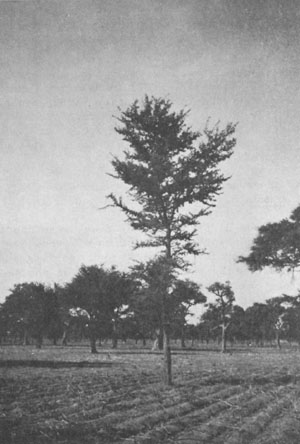
Field crops on A. albida woodland: some trees were lopped to feed the cattle (photo Y. Roederer/CTFT)
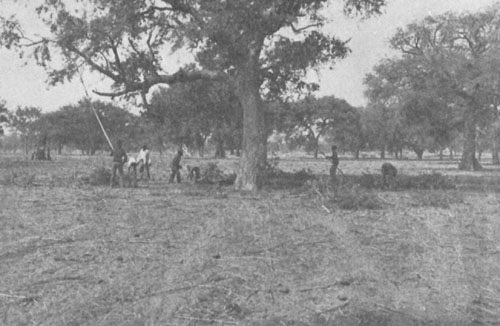
Collection of Acacia albida pods on the ground after the branches were lopped (photo Y. Roederer/CTFT)
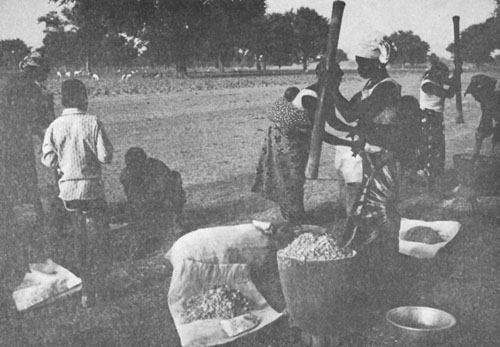
Extraction of seeds from pods by pounding in mortars.
(photo Y. Roederer/CTFT)
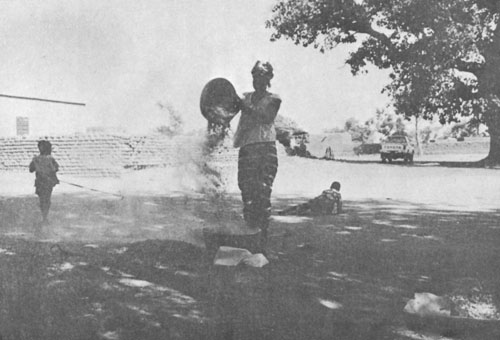
Separation of seeds from dust and waste by winnowing.
(photo Y. Roederer/CTFT)
 | 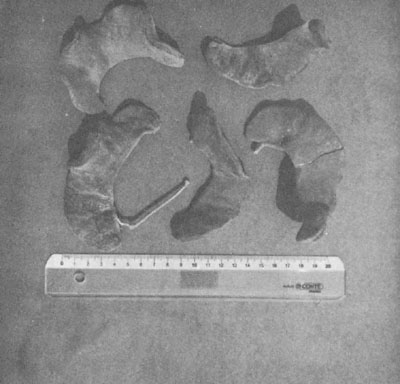 |
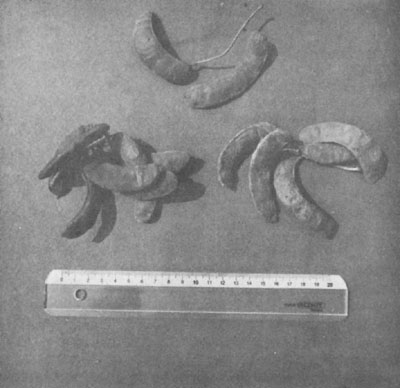 | |
| Variability in size and form of Acacia albida pods. (photo E. Forni/CTFT) | |
Table 1
ACACIA ALBIDA PROVENANCES AVAILABLE FOR INTERNATIONAL PROVENANCE TRIALS
| seeds available from: | CTFT |
| 45bis avenue de la Belle Gabrielle | |
| 94736 Nogent sur Marne, Cédex | |
| FRANCE |
| CTFT Seedlot Number | Provenance | Latitude | Longitude | Altitude | Mean Annual Rainfall | Number of Trees Collected |
| Cameroon | ||||||
| 86/6684 N | Guetalé | 10°57 N | 13°55 E | 450 | 850 | 18 |
| 86/6685 N | Mayo Sava/Mora | 10°58 | 14°12 | 450 | 780 | 14 |
| 86/6686 N | Adoumri/Bibemi | 9°16 | 13°50 | 220 | 875 | 13 |
| 86/6687 N | Bogo | 10°43 | 14°32 | 300 | 780 | 16 |
| 86/6688 N | Moulvouday | 10°23 | 14°50 | 330 | 800 | 20 |
| 86/6689 N | Makary | 12°35 | 14°28 | 286 | 500 | 10 |
| 86/6690 N | Doukoula | 10°07 | 14°58 | 300 | 813 | 18 |
| Mali | ||||||
| 86/6679 N | Segou | 13°25 N | 6°15 W | 280 | 726 | 20 |
| 86/6680 N | Mio Kolongotomo | 13°49 | 5°48 | 280 | 650 | 17 |
| 86/6681 N | Baroueli | 13°05 | 6°51 | 250 | 800 | 17 |
| 86/6682 N | Kemeny | 12°58 | 5°40 | 270 | 760 | 18 |
| 86/6683 N | Sarro | 13°42 | 5°15 | 250 | 585 | 17 |
| Niger | ||||||
| 86/6691 N | Kollo | 13°18 N | 2°21 E | 210 | 595 | 17 |
| 86/6692 N | Tera | 14°00 | 0°45 | 240 | 458 | 18 |
| 86/6693 N | Bouza | 14°25 | 6°07 | 300 | 451 | 19 |
| 86/6695 N | Madarounfa | 13°19 | 7°09 | 360 | 598 | 21 |
| 86/6696 N | Matameye | 13°25 | 8°28 | 480 | 560 | 18 |
When pretreated the seedlots have a germination ranging between 70 and 95%.
1 Manuscript received in December 1986.
2 See also article by E. Bonkoungou on A. albida, published in FGRI No. 13 (1985)